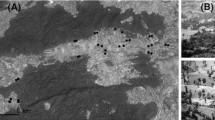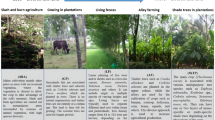Abstract
Tropical landscapes are dominated by agroecosystems, but the potential value of agroecosystems for the survival of species is often overlooked. In agroecosystems, species conservation is especially important when functional groups such as predators are affected. In Central Sulawesi, we sampled arthropods on cocoa in a gradient of land-use intensity from extensively used forest gardens to intensively used agroforestry systems. The abundance and diversity of all arthropods did not correlate with land-use intensity, so human impact was not followed by high species losses. However, the number of species and abundance of the phytophagous arthropods increased and that of the entomophagous arthropods decreased with land-use intensity. The reduced predator–prey ratio in intensified systems can be related to their reduced species richness of shade trees and the changed microclimate (increased temperature, decreased humidity and canopy cover). In conclusion, transformation of traditional into intensified agroforestry systems had a great impact on arthropod community structure on cocoa. Since predator–prey ratios decreased with increasing land-use intensity, local farmers should have least pest problems in the traditionally diversified agroforestry systems.
Similar content being viewed by others
References
Altieri MA (1995) Agroecology. Westview Press, Boulder
Beer J (1987) Advantages, disadvantages and desirable characteristics of shade trees for coffee, cacao and tea. Agroforestry Systems 5: 3-13
Braun-Blanquet J (1964) Pflanzensoziologie. Grundzüge der Vegetationskunde. Springer, Wien
Corbett A and Rosenheim JA (1996) Impact of natural enemy overwintering refuge and its interaction with the surrounding landscape. Ecological Entomology 21: 155-164
Daily GC, Alexander S, Ehrlich PR, Goulder L, Lubchenko J,M atson PA, Mooney HA, Postel S, Schneider SH, Tilman D and Woodwell GM (1997) Ecosystem services: benefits supplied to human societies by natural ecosystems. Issues in Ecology 2: 2-16
Didham RK, Ghazoul J, Stork NE and Davis A (1996) Insects in fragmented forests: a functional approach. Trends of Ecology and Evolution 11: 255-260
Donald J, Dwight M and Charles A (1981) The Introduction to the Study of Insects. CBS College Publishing, Canada
Fiedler K (1996) Interactions between lycaenid butterflies and ants in Peninsular Malaysia. In: Edwards DS et al. (eds) Tropical Rainforest Research, Current Issues, pp 291-296. Kluwer Academic Publishers, Dordrecht, The Netherlands
Greenberg R, Bichier P, Cruz Angon A, MacVean C, Perez R and Cano E (2000) The impact of avian insectivory on arthropods and leaf damage in some Guatemalan coffee plantations. Ecology 81: 1750-1755
Kalshoven LGE (1981) Pest of crops in Indonesia. PT Ichtiar Baru-Van Hoeve, Jalan Majapahit 6, Indonesia
Klein A-M, Steffan-Dewenter J and Tscharntke T (2001) Effects of land-use intensity in tropical agroforestry systems on flower-visiting and trap-nesting bees and wasps(submitted to Conservation Biology)
Laurance VF and Bierregaard Jr RO (1997) Tropical Forest Remnants. The University of Chicago Press, Chicago
Lawton JH, Bignell DE, Bolton B, Bloemers GF, Eggleton P, Hammond PM, Hodda M, Holt RD, Larsen TB, Mawsley NA, Stork NE, Srivastava DS and Watt AD (1998) Biodiversity inventories, indicator taxa and effects of habitat modification in tropical forest. Nature 391: 72-76
Leston D (1970) Entomology of the cocoa farm. Annual Review of Entomology 15: 273-294
Manugistics (1996) Statgraphics plus for Windows 3.0 Manugistics Inc
Moguel P and Toledo VM (1999) Biodiversity conservations in traditional coffee systems of Mexico. Conservation Biology 13: 11-22
Oliver JO and Beattie AJ (1996) Designing a cost-effective invertebrate survey: a test of methods for rapid assessment of biodiversity. Ecological Applications 6: 594-607
Perfecto I (1990) Indirect and direct effects in a tropical agroecosystem: the maize-pest-ant system in Nicaragua. Ecology 71: 2125-2134
Perfecto I, Rice RA, Greenberg R and Van der Voort ME (1996) Shade coffee: a disappearing refuge for biodiversity. Shade coffee plantations can contain as much biodiversity as forest habitats. BioScience 46: 598-608
Perfecto I and Vandermeer J (1996) Microclimatic changes and the indirect loss of ant diversity in a tropical agroecosystem. Oecologia 108: 577-582
Perfecto I, Vandermeer J, Hanson P and Cartin V (1997) Arthropod biodiversity loss and the transformation of a tropical agro-ecosystem. Biodiversity and Conservation 6: 935-945
Pimentel D, Stachow U, Takacs DA, Brubaker HW, Dumas AR, Meaney JJ, O'Neil JAS, Onsi DE and Corzilius DB (1992) Conserving biological diversity in agricultural/forestry systems. Most biological diversity exists in human-managed ecosystems. BioScience 42: 354-362
Power AG (1996) Arthropod diversity in forest patches and agroecosystems of tropical landscapes. In: Schelhas J and Greenberg R (eds) Forest Patches in Tropical Landscapes, pp 91-110. Island Press, Washington
Power AG and Flecker AS (1996) The role of biodiversity in tropical managed ecosystems. In: Orians GLH, Dirzo R and Cushman JH (eds) Biodiversity and Ecosystem Processes in Tropical Forests. Ecological Studies, Vol 122, pp 173-194. Springer Verlag, Berlin
Power AG and Flecker AS (2000) Agroecosystems and Biodiversity. http://www.si.edu/smbc/cacao/power. Htm
Rice RA and Greenberg R (2000) Cacao cultivation and the conservation of biological diversity. Ambio 29: 167-174
Root RS (1973) Organization of a plant-arthropod association in simple and diverse habitats: the fauna of collards (Brassica oleracea). Ecological Monographs 43: 95-120
Russel EP (1989) Enemy hypothesis: a review of the effect of vegetational diversity on predatory insects and parasitoids. Environmental Entomology 18: 590-599
Schelhas J and Greenberg R (1996) Forest Patches in Tropical Landscapes. Island Press, Washington
Sokal RR and Rohlf FJ (1995) Biometry, the Principles and Practice of Statistics in Biological Research. Fremsn and Company, New York
Soule J, Carré D and Jackson W (1990) In: Carroll CR, Vandermeer JH and Rosset PM (eds) Ecological Impact of Modern Agriculture Agroecology. pp 113-188, McGraw-Hill, New York, USA
Stork NE (1991) Insect diversity: facts, fiction and speculation. Biological Journal of the Linnean Society 35: 321-337
Thies C and Tscharntke T (1999) Landscape structure and biological control in agroecosystems. Science 285: 893-895
Tscharntke T (2000) Parasitoid populations in the agricultural landscape. In: Hochberg ME and Ives AR (eds) Parasitoid Population Biology, pp 235-254. Princeton University Press, Princeton
Watt AD, Stork NE, Eggleton P, Srivastara D, Bolton B, Laren TB, Brendell MJD and Bignell DE (1997) Impact of forest loss and regeneration on insect abundance and diversity. In: Watt SD, Stork NE and Hunter MD (eds) Forest and Insects, pp 273-286. Chapman and Hall, London
Western D and Pearl MC (1989) Conservation for the Twenty-first Century. Oxford University Press, New York
Young AM (1994) The Chocolate Tree. Smithsonian Institution, Washington and London
Author information
Authors and Affiliations
Rights and permissions
About this article
Cite this article
Klein, AM., Steffan-Dewenter, I. & Tscharntke, T. Predator–prey ratios on cocoa along a land-use gradient in Indonesia. Biodiversity and Conservation 11, 683–693 (2002). https://doi.org/10.1023/A:1015548426672
Issue Date:
DOI: https://doi.org/10.1023/A:1015548426672




